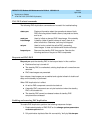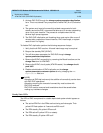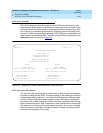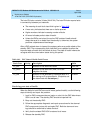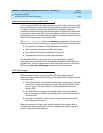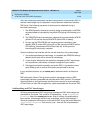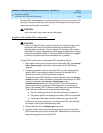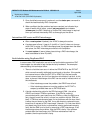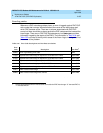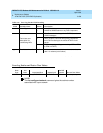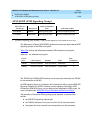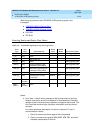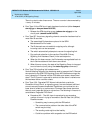
DEFINITY ECS Release 8.2 Maintenance for R8.2csi
555-233-119 Issue 1
April 2000
Maintenance Objects
3-205ATM PNC-DUP (ATM PNC Duplication)
3
Demand PNC interchanges also invoke anti-thrashing, but only for a period of 30
seconds. During antithrashing mode, demand interchanges are also prevented
unless the override option is specified.
!
CAUTION:
Use of this option may cause a service disruption.
Repairs on the standby PNC components
!
CAUTION:
If there is a TDM-CLK alarm, system timing may be routed through part of
the standby PNC, and circuit switched data may be affected by the
following repair procedures. This can happen, for example, when a slave
tone/clock circuit pack experiences a loss of signal and switches to receive
timing from the standby ATM-EI. In this case TDM-CLK 2305 error is logged,
and the clock problem should be addressed first, if possible.
To repair PNC components in a duplicated PNC proceed as follows:
1. Most repairs involve fixing a single fault on the standby PNC. Use
set pnc
lock
or
busy-out pnc
to prevent an interchange into the PNC being
repaired.
2. If a faulty component exists on the active PNC, this also means that the
standby PNC is more severely faulted. Normally, the
standby
PNC is
repaired first, since it is the most severely impaired.
To repair the active PNC (standby is already repaired), issue the
set pnc
unlock
command, which generates a spontaneous interchange. In a PNC
demand interchange with
reset pnc interchange
use the
override-and-lock
qualifier for the active PNC. The
override-and-lock
option ensures that no subsequent interchange can occur during the
repair of the standby PNC. A demand interchange may not be necessary
if the following conditions drive a spontaneous interchange:
■ The anti-thrashing period from the last interchange has expired.
■ The global refresh from releasing the standby PNC has completed.
■ The standby PNC State of Health is better than the active PNC.
At this point, the faulty component is on the standby PNC, and the PNCs
are locked in their current active/standby state.
3. Busyout the PNC with the
busyout pnc
command.
4. Use fault isolation and component testing procedures for the individual
PNC components, just as for a simplex PNC. Replacement of components
does disrupt operation of the active PNC.





